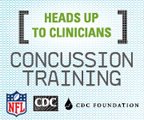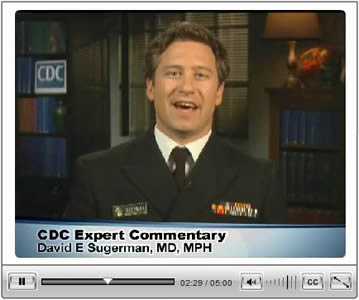Managing Return to Activities
Information for Health Care Professionals
Appropriate diagnosis, referral, and patient and family/caregiver education are critical for helping patients with mild TBI (MTBI) achieve optimal recovery and to reduce or avoid significant adverse health outcomes. However, diagnosing MTBIs can be challenging as symptoms of MTBI are common to those of other medical conditions and the onset and/or recognition of symptoms may occur days or weeks after the initial injury.
Therefore, CDC has collaborated with multiple organizations and leading experts to develop clinical guidelines and tools for diagnosis and management of patients with MTBI.
Returning to Daily Home/Community Activities
Increased rest and limited exertion are important to facilitate the patient’s recovery. Physicians should be cautious about allowing patients to return to driving, especially if the patient has problems with attention, processing speed, or reaction time. Patients should also be advised to get adequate sleep at night and to take daytime naps or rest breaks when significant fatigue is experienced. Symptoms typically worsen or re-emerge with exertion. Let any return of a patient’s symptoms be the guide to the level of exertion or activity that is safe.
Returning to School
Symptomatic students may require active supports and accommodations in school, which may be gradually decreased as their functioning improves. Inform the student’s teacher(s), the school nurse, psychologist/counselor, and administrator of the student’s injury, symptoms, and cognitive deficits. For details on returning to school, see the following resources:
Returning to Work
Return-to-work planning should be based upon careful evaluation of symptoms and neurocognitive status. To help expedite recovery from MTBI, patients may initially need to reduce both physical and cognitive exertion. Rest is key. Restricting work during initial stages of recovery may be indicated to help facilitate recovery. Repeated evaluation of both symptoms and cognitive status is recommended to help guide management considerations.
Returning to Play (Sports and Recreation)
Guiding the recovery of individuals of any age with MTBI who participate in competitive or recreational activities requires careful management to avoid re-injury or prolonged recovery. Athletes engaged in collision sports require special management and evaluation to ensure full recovery prior to their return to play.
Managing an Athlete with a Concussion
For many health care professionals, the first chance to assess a young athlete with a suspected concussion will not be on the sidelines, but an office or emergency department. This examination will likely include a physical examination, covering cognition, neurology, balance, and most importantly, any signs of deteriorating neurological function.
When managing an athlete with concussion, a health care professional’s management plan should cover both returning to school and to play, and should:
- Monitor both physical and cognitive activities
- Consider concussion history
- Be individualized to the athlete
Outside of the emergency department, in most cases, it will be possible to monitor the athlete where you work--especially if the number and severity of symptoms are steadily decreasing and gone within 7 to 14 days.
For health care professionals working in an emergency department, an athlete should be referred for follow up care from a health care professional who can help him or her gradually return to school and to play when fully recovered. An athlete should not leave an emergency department and return to practice or play the same day nor should a future return to practice or play date be given at the time of an emergency department visit.
Return to Play Progression
There are five gradual steps to help safely return an athlete to play:
Baseline: No Symptoms
As the baseline step of the Return to Play Progression, the athlete needs to have completed physical and cognitive rest and not be experiencing concussion symptoms for a minimum of 24 hours. Keep in mind, the younger the athlete, the more conservative the treatment.
Step 1: Light aerobic activity
The Goal: Only to increase an athlete’s heart rate.
The Time: 5 to 10 minutes.
The Activities: Exercise bike, walking, or light jogging.
Absolutely no weight lifting, jumping or hard running.
Step 2: Moderate activity
The Goal: Limited body and head movement.
The Time: Reduced from typical routine.
The Activities: Moderate jogging, brief running, moderate-intensity stationary biking, and moderate-intensity weightlifting
Step 3: Heavy, non-contact activity
The Goal: More intense but non-contact
The Time: Close to typical routine
The Activities: Running, high-intensity stationary biking, the player’s regular weightlifting routine, and non-contact sport-specific drills. This stage may add some cognitive component to practice in addition to the aerobic and movement components introduced in Steps 1 and 2.
Step 4: Practice & full contact
The Goal: Reintegrate in full contact practice.
Step 5: Competition
The Goal: Return to competition.
It is important to monitor symptoms and cognitive function carefully during each increase of exertion. Athletes should only progress to the next level of exertion if they are not experiencing symptoms at the current level. If symptoms return at any step, an athlete should stop these activities as this may be a sign the athlete is pushing too hard. Only after additional rest, when the athlete is once again not experiencing symptoms for a minimum of 24 hours, should he or she start again at the previous step during which symptoms were experienced.
The Return to Play Progression process is best conducted through a team approach and by a health professional who knows the athlete’s physical abilities and endurance. By gauging the athlete’s performance on each individual step, a health care professional will be able to determine how far to progress the athlete on a given day. In some cases, the athlete may be able to work through one step in a single day, while in other cases it may take several days to work through an individual step. It may take several weeks to months to work through the entire 5-step progression.
Before the start of the season, health care professionals should learn about state, league, or sports governing body’s laws or policies on concussion Some policies may require health care professionals to take a training program or provide written clearance as part of the return to play process for young athletes.
When to Refer to a Specialist
Remember, while most athletes will recover quickly and fully following a concussion, some will have symptoms for weeks or longer. Health care professionals should consider referral to a concussion specialist if:
- The symptoms worsen at any time,
- The symptoms have not gone away after 10-14 days, or
- The patient has a history of multiple concussions or risk factors for prolonged recovery. This may include a history of migraines, depression, mood disorders, or anxiety, as well as developmental disorders such as learning disabilities and ADHD.
CDC Expert Commentary Video on Returning to Play
CDC Expert Commentary: Hey Doc, When Can I Return to Play?
(Free login required through Medscape.com to view the video)
Online Training for Health Care Providers
 HEADS UP to Clinicians: Addressing Concussion in Sports among Kids and Teens is a free, online course, available to health care providers. It provides an overview of what you, as a health care professional, need to know about concussion among young athletes.
HEADS UP to Clinicians: Addressing Concussion in Sports among Kids and Teens is a free, online course, available to health care providers. It provides an overview of what you, as a health care professional, need to know about concussion among young athletes.
Free CME, CNE and CEU credits available at the end of the course.
- Page last reviewed: February 8, 2016
- Page last updated: February 8, 2016
- Content source:
- Centers for Disease Control and Prevention,
- National Center for Injury Prevention and Control,
- Division of Unintentional Injury Prevention


 ShareCompartir
ShareCompartir
